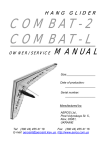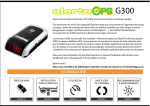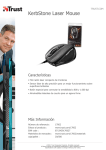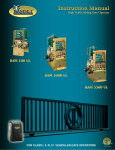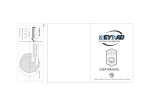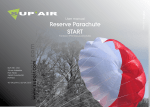Download Emergency Parachute Advice - British Hang Gliding and Paragliding
Transcript
Pilot Handbook:Handbook 10/7/08 02:22 Page 44 Chapter 7: Safety equipment Emergency parachutes An emergency parachute gives you a second chance, perhaps a final chance, when some catastrophe occurs. This section details the important points about buying, installing, maintaining and using a parachute. Hopefully this will increase the chances of the emergencyparachute system working successfully if it is ever needed. The basic parachute system comprises the canopy and its lines, its bridle and the attachment to the harness. The system is completed by the deployment bag, which holds the packed canopy and lines, all stowed in a container which is fitted securely to the pilot’s harness. The early emergency parachutes produced for hang gliding used round or ‘conical’ shaped canopies. Since the late 1980s virtually all emergency parachutes produced for hang gliding and paragliding are of the pulleddown-apex design (or variations on it). A central line holds the middle of the open canopy more or less level with the skirt, so that air pressure forces the skirt out and the canopy presents the maximum drag area for the smallest amount of material. Such designs are also very rapid opening. The downside of these types is that some designs can be very unstable and can produce massive opening shocks: both of these can be catastrophic, so it is important that you buy a properly independently tested and approved product. conical pulled-apex Figure 7.1 Conical and pulled-apex emergency parachutes 44 Pilot Handbook:Handbook 10/7/08 02:22 Page 45 Chapter 7: Safety equipment Choosing a parachute Buying a parachute that is clearly marked as conforming to the CEN standard EN12491 is strongly recommended. Such parachutes will have passed rigorous speed of opening tests, descent rate tests (max. 5.5m/s), stability tests and strength tests. In the strength test the manufacturer has the choice of two test speeds, and the successfully certified parachutes therefore carry on the certification label the warning: ‘not suitable for speeds in excess of 32m/s (115km/h)’ OR ‘not suitable for speeds in excess of 49m/s (176km/h)’. Other than checking the certification label and deciding whether you will be happy with the lower speed certification or whether you want the added strength of the higher speed tested alternatives, the final very important thing you need to do is check that it is available in a size suitable for your total weight in flight (this figure includes the weight of your glider). If you buy a parachute not certified to EN12491 then the earlier DHV and AFNOR standards give some measure of quality assurance, but you must be careful to ensure that the parachute you select will give an acceptable descent rate at your total weight in flight. Look for one with documented rates of descent at different loads, and choose one that will give a descent rate of less than 7.5m/sec (ideally around 5.5m/sec) at your total weight in flight. Descent rates / equivalent fall height: As the expected descent rate increases, so does the likelihood of injury and its severity. A descent rate of approximately 5.5m/s (18ft/s) is recommended as this keeps the likelihood of injury low while keeping all the other design factors (parachute bulk, weight) manageable. Slightly higher descent rates are acceptable, but a descent rate of 7.5m/s (24.5ft/s) should be regarded as being the maximum limit: any existing parachute system that will, at your all-up weight, give you a sea-level descent rate greater than 7.5m/s should be replaced. It is sometimes easier to visualise vertical descent rates by equating them to stepping off a wall of a certain height. 5.5m/s (18ft/s or 12.3mph) is your velocity when you hit the ground after stepping off a wall 1.5m (5ft) high. A descent rate of 7.5m/s is equivalent to a drop of 2.5m (8.2ft). When you have imagined falling from this height onto your feet and doing a PLF, try imagining falling from this height onto your back, or your side, or your head… You should also bear in mind that in an actual emergency, factors such as lift, sink, altitude, a semi-inflated paraglider or a damaged hang glider may all conspire to increase or decrease your descent rate. 45 Pilot Handbook:Handbook 10/7/08 02:22 Page 46 Section 2: Know Your Equipment Buying second-hand There is nothing intrinsically wrong with buying a second-hand parachute, but you are strongly advised to have it inspected by a BHPAlicensed ‘Parachute Systems Checker and Packer’. Many parachutes sold to hang glider pilots in the 1990s were far too small and could produce fearsome descent rates if ever used at typical hang glider payloads, assuming the opening shock did not burst them or break the pilot’s harness. These should be avoided. The licensed packer will check that the parachute is the right size for you, has been well looked after, is not too old (ten years should be considered as the total life of a canopy – those without dates of manufacture, the manufacturer’s name and serial numbers should be avoided) and that it is in good serviceable condition. Checking parachute area There are many ways of measuring parachutes. To avoid confusion, BHPA-licensed packers all take the following simple steps: 1 Measure from the peripheral hem in the centre of a gore up to the very apex of the parachute (including the lines). This gives the y dimension. 2 Measure the width of the gore at the peripheral hem, and halve this figure. This gives the x dimension. y 3 Multiply x by y to give the surface area of the individual gore. 4 Multiply the result by the number of gores to get the total surface area of the parachute. x Figure 7.2 Measuring the surface area of a gore 46 Pilot Handbook:Handbook 10/7/08 02:22 Page 47 Chapter 7: Safety equipment Estimating descent rates where no data is available The graph below can be used to indicate the likely descent rate of a typical PDA canopy given your total weight in flight and the canopy area. (Check that your parachute area is measured using the BHPA method.) 135 130 imum ) 125 90 m/ rec 95 5.5 100 (BH 105 (BHP A-re load (kg) 110 sd es ce nt om rat me e nd ati on ) 7.5m /s de scen com t rate men ded abso lute max 115 PA - 120 85 80 75 70 15 20 25 30 35 40 45 PDA canopy area (m2) 50 55 60 65 Figure 7.3 Graph of canopy area against load for typical pulleddown-apex parachutes This graph is based on a Cd (Coefficient of drag) of 1.2, typical of many simple pulled-down-apex designs, although the actual Cd of a particular canopy will depend on a number of factors, including canopy shape, fabric permeability, line lengths and drive. (‘Drive’ means that the PDA canopy glides – usually contrary to the designer’s intent and expectation – and so creates lift, which helps reduce the descent rate: the downside is that your ground impact energy may be increased because of the lateral velocity, which may be significant.) The real descent rate is further complicated by stability. Live drop tests have shown that there can be a huge disparity in the way parachutes descend: whilst some are stable, many oscillate or ‘cone’ (a swirling sycamore-like action) which can greatly affect the descent rate. So this graph can only provide a ‘ballpark’ indication. 47 Pilot Handbook:Handbook 10/7/08 02:22 Page 48 Section 2: Know Your Equipment The graph should not be used when actual data is available, nor for anything other than conventional (non-slotted, non-steerable) PDA canopy types. User manual Ensure you receive a user manual with your parachute: this should contain instructions for installing it, using it and re-packing it, as well as data on performance, size and recommended load. Make sure that the parachute has the correct bridle for your glider type: • Hang-glider parachutes require a six-metre bridle to keep the parachute clear of the wreckage. • Single-riser paraglider parachutes require a short bridle with an additional Y-bridle to connect it to the two harness-attachment points. • Multi-riser paraglider parachutes connect the appropriate risers directly to the left and right harness-attachment points. The complete system Having the perfect parachute is not much use if it won’t fit in your harness, or if you can’t get it out of your harness when you need to, or if the connections to your harness are not strong enough. Emergency parachutes must be regarded as part of a complete system. For this reason you are strongly advised to buy a system from a BHPA-licensed packer, who will have the knowledge required to sort out the whole package, rather than just selling you an expensive component which may actually be of little or no use to you. Installing Always unpack and inspect a parachute before fitting it to your harness: it is not unusual to find faults in brand-new equipment, so check carefully. Be aware that many parachutes are shipped ‘packed for transit’ and look ready for use but are not! The parachute’s outer container must be mounted in a suitable place on the harness (although in many cases it is built into the harness). It may be on the front or on either side; with paraglider harnesses it could also be on the back or even under the seat. All of these positions have advantages and disadvantages: • Does the pack get in the way during take-off, flight or landing? • Does the pack location involve extra connections when putting the harness on for flight (which might be forgotten)? 48 Pilot Handbook:Handbook 10/7/08 02:23 Page 49 Chapter 7: Safety equipment • Is the mounting secure, so that the deployment bag can be extracted easily? • Can you see the handle? • Can you easily reach the handle with either hand? If you can only reach it with one hand, you have only half the chance of a successful deployment! • Is the handle likely to get accidentally caught and cause inadvertent deployment? Make sure that the parachute fits properly in the harness: quite a few harnesses have been manufactured with parachute containers which are far too small, and you may need to have such a container enlarged so that you can fit a parachute of suitable size. Make sure your emergency-parachute riser is correctly attached to your harness. Modern certified paraglider harnesses are supplied with tested loops on the shoulders: you must attach the parachute to both of these so the load is spread equally. With hang-glider harnesses the emergency parachute is connected to the main harness suspension point, using a separate steel maillon connector. The bridle(s) must be carefully routed to ensure that no twists will occur as your emergency parachute deploys and that the bridle(s) will not get tangled with your paraglider risers/hang glider hang-strap – or with you, the pilot – you do not want the bridle around your neck! (See the section on connectors in Chapter 8.) Check the whole system when it is put together, with you suspended in the harness in full flying kit: • Is the strop on the deployment handle strong enough to withstand the force of the pull? • Is the strop on the deployment handle the right length? It must pull the outer-cover closure pins completely clear before starting to drag the deployment bag out. If not, it will be impossible to extract the parachute no matter how hard you pull! • Can you easily deploy with either hand? If you are not 100% confident that you fully understand the whole list of items that must be matched and checked to create an effective emergency parachute system, then get a BHPA-licensed packer to install it properly for you and explain the system to you. In fact, even if you have put the system together yourself and feel confident that you have done a good job, why not invest in your future by having an independent 49 Pilot Handbook:Handbook 10/7/08 02:23 Page 50 Section 2: Know Your Equipment pair of eyes give it a check-over? Pilots of all abilities have been responsible for the many packing and installation errors discovered over the years. Maintenance and repacking Ideally every pilot should learn how to repack his or her own parachute, and so become completely familiar with the system. You can learn how to do this at a parachute-repacking evening organised by your local club (make sure that a BHPA-licensed packer will be supervising the evening). Alternatively, take your equipment to a BHPA-licensed packer and get the packer to show you how to repack it. (If you really don’t want to understand your emergency system, simply get the packer to do a full inspection and repack.) Repacking should be carried out at the intervals recommended in the parachute’s user manual. In the absence of such recommendations, check and repack your parachute every six months. (If it has become damp it should be aired immediately and repacked when completely dry.) Repacking provides an opportunity for a close examination of the entire parachute system for general viability and wear and tear. It also allows replacement of the rubber bands, which perish, with new bands of exactly the correct specification. By fitting a parachute your chances of surviving an in-flight catastrophe have been increased, but you are now exposed to the danger of experiencing an in-flight emergency in the form of an unintentional deployment. Approximately one in three deployments are unintentional! – this is mainly because pilots fail to check and maintain their equipment adequately. Pre-flight checks As part of your pre-flight actions: • Check that your parachute container is properly closed and that any closure pins are secure and free to release. • Check that the deployment handle is accessible. • Check that no slack loops of riser have slipped out of your parachute container. • Check that you have easy access to your hook knife. Be particularly careful with Velcro closure systems. As Velcro gets old, it can get clogged. It can also lock together over time, so a pull that is easy 50 Pilot Handbook:Handbook 10/7/08 02:28 Page 51 Chapter 7: Safety equipment when the parachute is first assembled can become almost impossible after six months. Pin closures are generally much better, but still need constant vigilance. Don’t be the next pilot to end up dangling beneath your ‘chute when you least expect it! Using your emergency parachute Practising Once you’ve got your system sorted out, the next job is to learn how to use it. Your emergency parachute’s user manual should advise you how to deploy for real, and how to practise (on the ground). Some clubs and schools have built suspended systems that you can strap into for practising deployment. Make full use of any simulator to which you have access: practise looking, grabbing and activating your parachute handle with first your right hand and then your left hand. Make sure you know whether the container requires you to pull in a certain direction. The slowest elements in deploying the emergency parachute are invariably: • making the decision • getting the parachute out of the harness and thrown. Time and effort spent in practising these actions and improving these parts of the system will pay the biggest dividends. When to deploy With situations such as a structural failure of your hang glider or paraglider, the appropriate action is clear: deploy the parachute! With paragliders there is a range of less clear situations where control of the canopy has been lost but may be regained. The decision whether or not to deploy will depend on the height that will be lost during your attempts at recovery and your initial proximity to the ground. Several pilots have been killed (and many injured) impacting the ground while still trying to recover control of their paragliders, when their parachutes would almost certainly have saved them. The crucial point is that any efforts to regain control of the paraglider must be secondary to the key concern of monitoring your height. Recovering from a complete mess is very satisfying if you have plenty of height to play with; however, descent rates can be extremely fast when a canopy is spinning out of control. Don’t leave deployment to the last minute. If in doubt, throw it out! 51 Pilot Handbook:Handbook 10/7/08 02:28 Page 52 Section 2: Know Your Equipment Cumulonimbus Do not deploy your parachute as a method of escaping from a cumulonimbus (not that you should ever allow yourself to get anywhere near one!). You will in all probability be swept up into the thundercloud while dangling powerlessly underneath your parachute. In such an emergency situation hang-glider pilots are probably best advised to try to fly away from the danger, while a paraglider pilot’s best option is probably to use the spiral dive rapid-descent technique. This will give a much higher descent rate than a parachute – perhaps 15m/s (50ft/s). Of course, if you have suffered catastrophic structural failure in the cloud your outlook is rather bleaker – you can throw the parachute and risk being swept up, or delay the throw and risk your parachute and/or harness being shredded by the opening shock. Whilst the latest CEN certified parachutes will survive an opening after a very few seconds of free-fall, most will not. And few, if any, current paraglider and hang-glider harnesses are designed to take free-fall parachuting shock loads. So keep clear of cu-nimbs. Deploying your parachute 1 LOOK for the deployment-bag handle. Harnesses (especially paraglider harnesses) can have a number of adjustment straps that may easily be confused with the parachute deployment handle in an emergency. Be sure to look for the correct handle so you don’t waste precious time tugging on the wrong strap – many parachutists have died through pulling a strap instead of the correct handle. 2 Reach and grab the handle securely. If your right hand is not available, use your left! 3 Get the parachute out. Some container systems require you to pull the handle in a certain direction to release the curved pins (safety locks) before you can extract your parachute. Some Velcro configurations require you to peel the opening flap downward to extract the parachute. It may even be that you need to use both hands to get the parachute out! Make sure that you know your equipment. 4 Look for clear air and throw the parachute out towards it. Throw hard. If it is possible, throw the parachute towards the sky, or upwards and out. – You can throw better if you grab the whole parachute deployment bag using both hands. 52 Pilot Handbook:Handbook 10/7/08 02:28 Page 53 Chapter 7: Safety equipment – Your riser(s) should come to full extension followed by your lines and canopy. If you get a good throw away from you, your system will open with less loss of height. If you drop your emergency parachute below you, you risk entanglement. You will also fall a greater distance before the parachute inflates and takes your body weight. – You may want to avoid throwing the parachute down between your legs. – Hang glider pilots may wish to avoid throwing the parachute through the control frame as this could result in the glider inverting, which usually limits the pilot’s ability to adopt a sensible landing position. 5 Look to make sure your parachute has opened. The deployment bag should release and the canopy start to deploy as soon as the bridle is at full stretch. If it does not, try yanking the bridle several times very hard. Hopefully, the parachute will inflate and the bridle will be yanked out of your hand. If this does not release the deployment bag, pull the parachute back in, hand over hand. Throw the parachute again. – If the deployment bag has released but your canopy has not yet inflated, yank vigorously on the bridle. This will help to spread the suspension lines and open an air channel. – If you are pulling on a parachute bridle, never wrap the line around your hand and let it go immediately the parachute starts inflating. The parachute will inflate with tremendous energy. 6 Prepare for impact. Paraglider pilots should assume the PLF position (see ‘Keep practising your PLFs!’ on page 11). Hang-glider pilots should unzip their harness and climb into the control frame, keeping their weight distributed towards both corners of the basebar. If this is not possible, concentrate on getting into a footdown/head-up position with your feet together and your knees slightly bent. Keep your arms and head tucked in. Try to use your legs as shock-absorbers by allowing them to flex as you impact. Allow your body to roll in the direction of the impact. After you impact, disconnect from the glider immediately (getting injured by being dragged across the countryside after a successful emergency-parachute descent would be a shame). Do whatever you need to do to get away from the glider and parachute, even if it means cutting the bridle or cutting your harness (use your hook knife). Deflate 53 Pilot Handbook:Handbook 10/7/08 02:28 Page 54 Section 2: Know Your Equipment the parachute by grabbing the hem at one side and taking it forward into the wind. Radio your friends to let them know your position and condition. You should also contact the local police, who may be launching a full-scale search if a member of the public has seen your descent and reported it. Preventing paraglider re-inflation With paraglider emergency-parachute systems it is possible for the paraglider to re-inflate after the emergency parachute has been deployed, and then for the two to ‘fight’ during the descent, sometimes with disastrous results. Various methods of disabling your paraglider to prevent this happening have been suggested, but the most important point here is that this problem is far less likely to occur if your parachute is the correct size for you. The lower your rate of descent under parachute, the less likely your paraglider will want to continue ‘flying’. If you do find yourself under your emergency parachute, and needing to disable a re-inflated paraglider, you must avoid any asymmetric action which could result in a free wing-tip thrashing around uncontrollably. Pulling both ‘C’-risers (to create a ‘C’-line stall) has been recommended by European test pilots, and may give additional drag, further slowing your descent. Steerable/gliding emergency parachutes Any steerable/gliding emergency parachute will have twin risers, or possibly four risers. As with most parachute design alternatives, the steerable emergency parachute concept has a trade-off. The main reason for having a steerable emergency parachute is so you can steer yourself away from any danger during the descent. The disadvantages are: • Because these parachutes rely on forward glide for them to create lift, they require the paraglider to be disabled or released, otherwise it will re-inflate • They tend to be complicated to re-pack, with more chance of difficulties when opening • If you do not have the space to manoeuvre for a landing into wind, an uncontrolled landing is likely to be downwind, at wind speed plus glide speed. Because of the hang-gliding requirement for a long single bridle, a steerable emergency parachute is not an option for hang-glider pilots. 54 Pilot Handbook:Handbook 10/7/08 02:28 Page 55 Chapter 7: Safety equipment Paraswivels Some hang-glider emergency parachutes are supplied with a swivel fitted into the bridle. It is not unusual for a broken hang glider to spin like a sycamore seed as it descends under an emergency parachute, and the swivel is intended to prevent the parachute suspension lines being twisted together if this happens. Such twisting could ultimately result in the canopy mouth being closed, with obvious dangers. Paraswivels are more common in countries where high-altitude flights are made regularly, and where a parachute descent is likely to take tens of minutes rather than the tens of seconds likely in the UK. Summary • An emergency parachute should be part of your flying equipment. • Choose one that will give you a true (non-gliding) descent rate of around 5.5m/sec (never more than 7.5m/sec) at your total weight in flight - including the weight of your glider. • Preferably choose a certified emergency parachute • Make sure that it is correctly connected to your harness and correctly installed (so that it can be deployed when you want, and won’t deploy unintentionally.) • Maintain it properly (which includes having it repacked regularly). • Make sure you know how to use it, and use it when you need to! Helmets Over the past forty years there has been a great deal of research into helmet technology, and the recent European CE standard ‘Helmets for Airborne Sports’ (EN 966) has benefited enormously from this accumulated knowledge. A helmet’s effectiveness can only be measured by expensive controlled testing of transmitted ‘g’ loads and other parameters, so you should place your trust in the CE standard and should only consider buying a helmet that conforms and is marked accordingly. The helmet’s function We wear helmets to try to prevent head injury, especially brain damage. The major cause of brain injury in an accident is through acceleration or deceleration of the brain. Think of the brain as a jelly in a jar: if a person falls over and bangs their head on a kerbstone, then the head is 55













